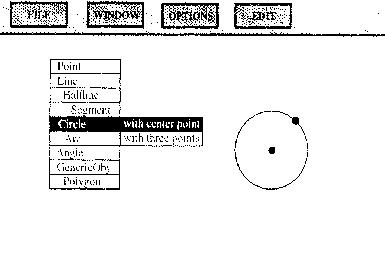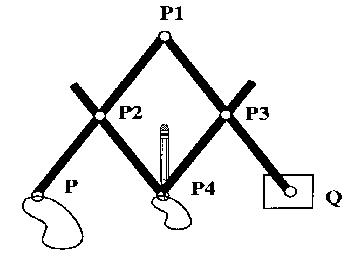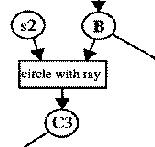GEObject
an Interactive Geometric Environment
 Tutorial |
 Handbook |
 Tutorial |
 Handbook |
GEObject is an interactive learning environment for
Euclidean Geometry.
It allows to build geometric objects by construction, adopting a compass-and-ruler paradigm.
Constructions can be modified applying geometrical transformations in a graphical direct manipulation interface, and the constraints, imposed to the figure during the construction, are preserved.
The system is object-oriented and has a built-in geometry knowledge base.
Geometric relationships and constraints are specified by messages exchange.
The knowledge base is incremental: users can add their constructions, both as new geometrical objects and as new functions to be applied to existing objects.

GEObject makes it possible to study and experiment Euclidean Geometry. Ever since ancient times mathematicians had to solve geometrical problems and to find general properties of geometrical figures: to show a possible solution to a problem often meant to provide a construction, the concept of formal proof came only later.
Euclid and geometers formalized the process of building a geometrical construction, adopting specific tools. In particular there had been a debate among geometers to individuate the minimal required tools to allow to draw given set of figures: compass and ruler, only a ruler, only a compass and so on. Galois proved that geometric objects that can be constructed using compass and ruler are those and only those that can be expressed in term of algebraic equations that can be solved by applying a finite number of rational operations or second order radicals.
Therefore now we know that not all constructions can be solved by using only compass and ruler. For instance the famous problem of trisecting an angle or the problem of finding the square of double area of a given square are not solvable by construction with those tools.

The user explores the Euclidean Geometry by the try and learn
paradigm.
Building geometric objects, giving them constraints and making
transformations, the student verifies the theoretic notions
previously learned, and explores and discovers properties,
learning by herself (or himself) new ones.
GEObject allows not to have misleading mental images, because
its internal stucture is object oriented based (as Euclidean Geometry is),
and this fact emerges through the interface.
The prototype GEObject is implemented in Eiffel, and runs on HP series
700 workstations.
Its architecture is hardly object-oriented: every geometric object is an
instance of a geometric class, and it's possible to create instances of
existent classes, or to create new classes.
Creating a geometric object, means calling a Creation Method, that
is a geometric procedure. Each class has its own creation methods.
A direct graph can be used to represent a geometric construction,
and an algorithm to propagate construction messages
allows to maintain constraints during the transformations.

The application is intended for students of geometry courses interested in
geometrical computing and computer graphics modelling.
It can be used by students directly or by teachers in classrooms to show
effectively how to make geometrical constructions, using the
Compass-and-Ruler mode.
Students can explore the topic and implement in the environment significant
examples, and carry on exercises that teachers can ask them to do.
Alberti M.A., Bastioli E., Marini D.
Towards Object-Oriented Modelling of Euclidean Geometry, The Visual Computer, 11 (7) 341-400, september 1995
Abstract.
Alberti M.A., Evi P., Marini D. Modelling Geometrical Objects with OBJSA nets, workshop on Petri nets and object-oriented programming, Torino giugno 1995
Abstract.
Alberti M.A., Evi P., Marini D.
GEObject: un ambiente di modellazione geometrica 2D, interattivo, incrementale ed object oriented,
Pixel, n. 5/6, pp. 13-23, 1996
Abstract.
 Milano
COLOS home page
Milano
COLOS home page